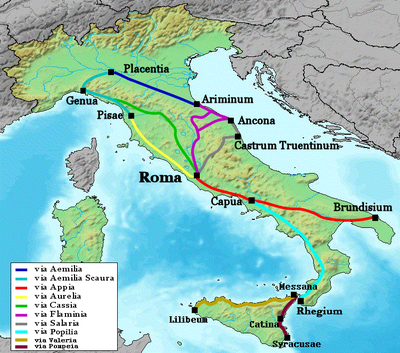Via Aurelia

The Via Aurelia was a Roman road constructed around the year 241 BC. The project was undertaken by C. Aurelius Cotta, who at that time was censor.[1] C. Aurelius Cotta had a history of building roads for Rome, as he had overseen the construction of a military road in Sicily (as consul in 252 BC, during the First Punic War) connecting Agrigentum (modern Agrigento) and Panormus (modern Palermo).[2]
Background
In the middle Republic, a series of roads were built throughout Italy to serve the needs of Roman expansion. These included swift army movements and reasonably quick communication with Roman colonies spread throughout Italy; there was also the unintended (but beneficial) consequence of an increase in trade among Italian cities and with Rome. The Via Aurelia was constructed as a part of this road construction campaign, which began in 312 BC with the building of the Via Appia. Other roads included in this construction period were the Viae Amerina (ca. 241 BC), Flaminina, Clodia, Aemilia, Cassia, Valeria (ca. 307 BC), and Caecilia (ca. 283 BC).[3]
Route
The Via Aurelia crossed the Tiber River by way of the bridge Pons Aemilius, then exited Rome from its west side. After the Emperor Aurelian built a wall around Rome (ca. 270 -273 AD), the Via Aurelia exited from the Porta Aurelia (gates). The road then ran about 25 miles to Alsium on the Tyrrhenian coast, north along the coast to Vada Volaterrana, Cosa and Pisae (modern Pisa). There the original length of the Via Aurelian terminated.[4] This was an especially important route during the early and middle Republic because it linked Rome, Cosa and Pisae. Cosa was an important colony and military outpost in Etruria, and Pisae was the only port between Genua and Rome. Consequently, it was an important naval base for the Romans in their wars against the Ligurians, Gauls and Carthaginians.[5][6]
The Via Aurelia was later extended roughly 200 miles in 109 BC by the Via Aemilia Scaura, constructed by M. Aemilius Scaurus. This road lead to Dertona (modern Tortona), Placentia, Cremona, Aquilea and Genua, from which one could travel to Gallia Narbonensis (southern France) by way of the Via Postumia.[7] By the time of the high Empire, one could travel from Rome by way of the Via Aurelia across the Alps via the Julian-Augustan Way to either northern France or Gades (modern Cadiz, Spain).[8]
The modern Strada Statale 1 occupies the same route, and is still referred to colloquially as La Via Aurelia.
Notes
- ^ Hornblower, Simon, & Antony Spawforth. The Oxford Classical Dictionary. 3rd ed. Oxford: Oxford University Press, 1996.
- ^ The Cambridge Ancient History. [New] ed. London: Cambridge University Press, 1970. Volume 7, p. 548 & 643
- ^ The Cambridge Ancient History. [New] ed. London: Cambridge University Press, 1970. Volume 8, p. 484.
- ^ Platner, Samuel Ball. A Topographical Dictionary of Ancient Rome. London, Oxford University Press, H. Milford, 1929. p. 561.
- ^ http://en.wikipedia.org/wiki/Pisa
- ^ Boatwright, Mary T., Daniel J. Gargola & Richard J.A. Talbert. A Brief History of the Romans. Oxford University Press, New York, USA, 2006. p. 48-49.
- ^ Hornblower, Simon, & Antony Spawforth. The Oxford Classical Dictionary. 3rd ed. Oxford: Oxford University Press, 1996.
- ^ Boumphrey, Geoffrey Maxwell. Along the Roman Roads. London: Allen & Unwin, 1935.
